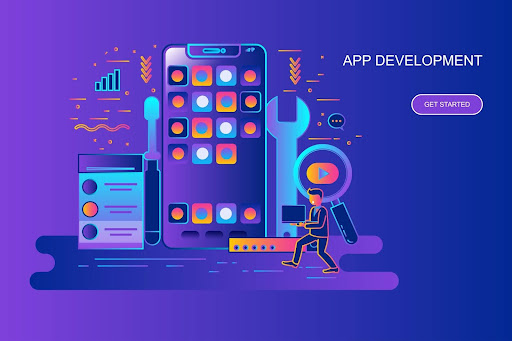Mobile applications are now highly essential for increasing user engagement as well as business growth in this digital landscape.
This understanding is crucial for anyone – whether an aspiring entrepreneur who has a unique idea to pursue or an already existing business looking to expand its digital presence. Today, we’ll discuss the entire mobile app development process, from idea to launch. So, let’s get started!
9 Steps to Develop Your Next Mobile App
Here are some crucial steps you must keep in mind while building your own mobile app:
Step 1: Define Your App Idea
A successful mobile application begins with a good idea. Make sure you take enough time to brainstorm and define your concept. Ask yourself:
- What problem does my app solve?
- Who is my target audience?
- What will distinguish my app?
A clear and concise outline of the project can help outline your thoughts and create a roadmap for development.
Step 2: Do Market Research
Once you have a clear concept, validate it by checking the market. Research the competition like other similar applications in the market, and get opinion from the potential users themselves. Also, find those gaps which your application may fill.
It is this process that ensures that your app is not only feasible but also competitive. You’ll have to do surveys and focus groups on user preference and behavior, too.
Step 3: A Wireframe
This wireframe will be your kind of visual framework that basically represents the structure and functioning of your app. Wireframes are pre-conceptual designs that hint on the UI and UX that an app is likely to have. You can draw these using Sketch or Figma, creating a very skeletal version of your app.
This stage is about the flow of your app. How do users navigate from one feature to another? A well-structured wireframe can significantly improve the user experience once the app is developed.
Step 4: Choose Your Development Approach
Next, you need to decide how you want to develop your app. There are primarily three approaches:
- Native App Development: Building specific applications to run on any platform- iOS, Android-and are built using that respective language that is native- Swift or Kotlin. In return, that is most effective performance-wise but pricey in development.
- Cross-platform Development: In this methodology, using frameworks such as React Native, Flutter, etc., a single product would be developed for both iOS and Android with very minor performance trade-offs. Although it may be costlier as a whole process, Android application development services benefit from significantly reduced development time compared to Native development.
- Hybrid App Development: A mixture of native and web applications. Development time is short; user experience is compromised.
The development in the above-mentioned models can easily be applied by developers working in India who offer diversified skills in a method to get their services on low-scale charges.
Step 5: Designing the User Experience and UI
The design phase is perhaps the most crucial part of the process as it strikes at the heart of engaging users. Reflect on how you can build a straightforward, intuitive design that does justice to your brand identity. Design principles to consider:
- Simplicity: Avoid clutter; make it easy to navigate.
- Consistency: Ensure that the design elements are uniform throughout the app.
- Feedback: Give the user feedback on the actions they’ve taken, for example, button clicks.
The only thing that distinguishes well-designed apps from all those others is their ability not only to attract users but to make them return.
Step 6: Development and Testing
Once the final design of the app has been set, the development process comes into action. You can always hire a mobile app development company in India for help. They can provide professional assistance in helping you shape your vision into something real with efficiency.
In case the final step in continuous testing during development were functional, usability, performance, and security testing, all the identified bugs should be fixed way before it even hits the marketplace to make sure it does run smoothly before users do.
Step 7: Prepare for Launch
Once your app reaches the launch stage, make preparations for a deployment. Pre-launching includes the creation of marketing strategies by considering the following items:
- Pre-launch Buzz: Start building buzz through social media and email marketing.
- ASO: This probably is one of the best ways in which you can enhance search rankings for your apps by optimizing listings with proper keywords, detail-rich descriptions, and eye-catchy visuals.
- Launch Date: Choose your launch date as you need to align it with the marketing strategy. You may invite influencers or early adopters to give momentum to good voices during the launch.
Step 8: Launch Your App
All is set, and you’re ready to deploy your app. Deploy it to popular platforms like the Apple App Store and Google Play Store. Track downloads and feedback closely in the days that follow.
Prepare for the initial glitches. Not all apps launch perfectly, and user feedback is always great for immediate changes.
Step 9: Support and Updates After Deployment
This is simply where you just launch the application. Continuous improvement holds users intrigued. It’s done either through updates and fixes where the new features may be introduced, bugs that may need to be deleted, or performance optimized for better speed. Attending what the users provide as their feedback will best help to understand their expectations and requirements.
You could also consider a support system that will assist the users in case they face problems while using your app. Good customer support enhances loyalty but also promotes reputation for your application.
Conclusion
A great mobile app development journey covers the complete process, from idea generation to launching. These are the steps to be taken and how professionals can build their next app. However, you need to hire mobile app developers in india from trusted firms like iWebServices to better succeed in this venture.
It would help you to stay ahead with the latest trends and other in-demand technologies, which can keep your application competent at market levels. So what are you waiting for? Create your next app today!











